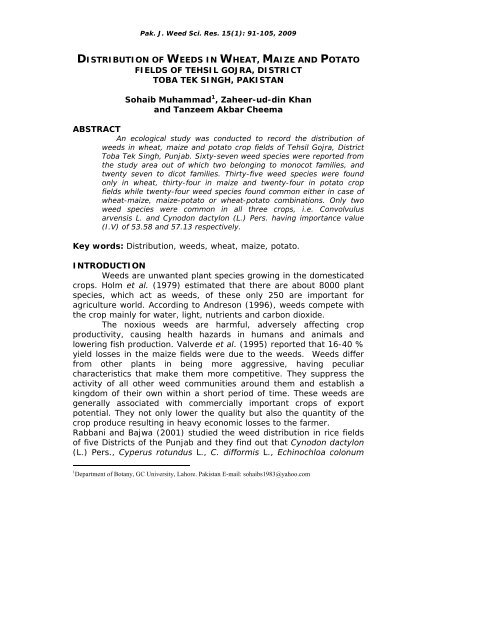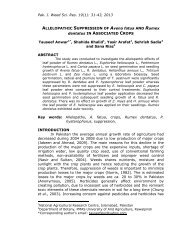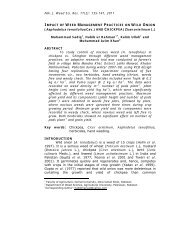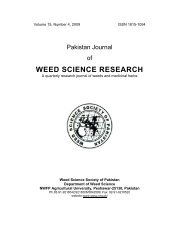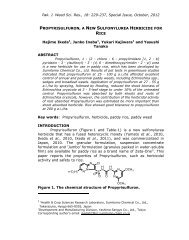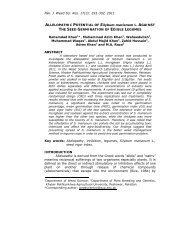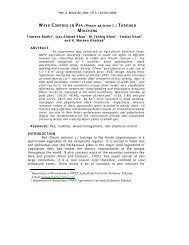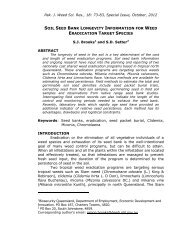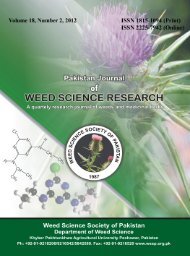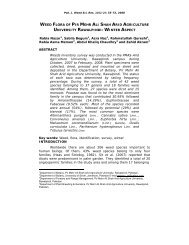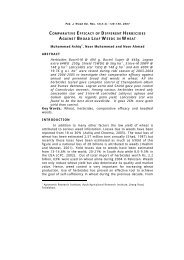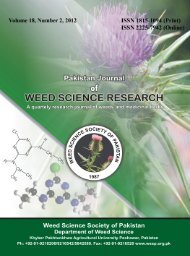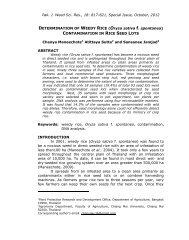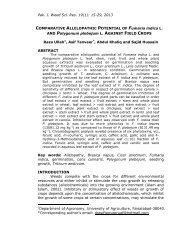distribution of weed in wheat, maize and potato fields ... - Wssp.org.pk
distribution of weed in wheat, maize and potato fields ... - Wssp.org.pk
distribution of weed in wheat, maize and potato fields ... - Wssp.org.pk
Create successful ePaper yourself
Turn your PDF publications into a flip-book with our unique Google optimized e-Paper software.
Pak. J. Weed Sci. Res. 15(1): 91-105, 2009<br />
DISTRIBUTION OF WEEDS IN WHEAT, MAIZE AND POTATO<br />
FIELDS OF TEHSIL GOJRA, DISTRICT<br />
TOBA TEK SINGH, PAKISTAN<br />
Sohaib Muhammad 1 , Zaheer-ud-d<strong>in</strong> Khan<br />
<strong>and</strong> Tanzeem Akbar Cheema<br />
ABSTRACT<br />
An ecological study was conducted to record the <strong>distribution</strong> <strong>of</strong><br />
<strong>weed</strong>s <strong>in</strong> <strong>wheat</strong>, <strong>maize</strong> <strong>and</strong> <strong>potato</strong> crop <strong>fields</strong> <strong>of</strong> Tehsil Gojra, District<br />
Toba Tek S<strong>in</strong>gh, Punjab. Sixty-seven <strong>weed</strong> species were reported from<br />
the study area out <strong>of</strong> which two belong<strong>in</strong>g to monocot families, <strong>and</strong><br />
twenty seven to dicot families. Thirty-five <strong>weed</strong> species were found<br />
only <strong>in</strong> <strong>wheat</strong>, thirty-four <strong>in</strong> <strong>maize</strong> <strong>and</strong> twenty-four <strong>in</strong> <strong>potato</strong> crop<br />
<strong>fields</strong> while twenty-four <strong>weed</strong> species found common either <strong>in</strong> case <strong>of</strong><br />
<strong>wheat</strong>-<strong>maize</strong>, <strong>maize</strong>-<strong>potato</strong> or <strong>wheat</strong>-<strong>potato</strong> comb<strong>in</strong>ations. Only two<br />
<strong>weed</strong> species were common <strong>in</strong> all three crops, i.e. Convolvulus<br />
arvensis L. <strong>and</strong> Cynodon dactylon (L.) Pers. hav<strong>in</strong>g importance value<br />
(I.V) <strong>of</strong> 53.58 <strong>and</strong> 57.13 respectively.<br />
Key words: Distribution, <strong>weed</strong>s, <strong>wheat</strong>, <strong>maize</strong>, <strong>potato</strong>.<br />
INTRODUCTION<br />
Weeds are unwanted plant species grow<strong>in</strong>g <strong>in</strong> the domesticated<br />
crops. Holm et al. (1979) estimated that there are about 8000 plant<br />
species, which act as <strong>weed</strong>s, <strong>of</strong> these only 250 are important for<br />
agriculture world. Accord<strong>in</strong>g to Andreson (1996), <strong>weed</strong>s compete with<br />
the crop ma<strong>in</strong>ly for water, light, nutrients <strong>and</strong> carbon dioxide.<br />
The noxious <strong>weed</strong>s are harmful, adversely affect<strong>in</strong>g crop<br />
productivity, caus<strong>in</strong>g health hazards <strong>in</strong> humans <strong>and</strong> animals <strong>and</strong><br />
lower<strong>in</strong>g fish production. Valverde et al. (1995) reported that 16-40 %<br />
yield losses <strong>in</strong> the <strong>maize</strong> <strong>fields</strong> were due to the <strong>weed</strong>s. Weeds differ<br />
from other plants <strong>in</strong> be<strong>in</strong>g more aggressive, hav<strong>in</strong>g peculiar<br />
characteristics that make them more competitive. They suppress the<br />
activity <strong>of</strong> all other <strong>weed</strong> communities around them <strong>and</strong> establish a<br />
k<strong>in</strong>gdom <strong>of</strong> their own with<strong>in</strong> a short period <strong>of</strong> time. These <strong>weed</strong>s are<br />
generally associated with commercially important crops <strong>of</strong> export<br />
potential. They not only lower the quality but also the quantity <strong>of</strong> the<br />
crop produce result<strong>in</strong>g <strong>in</strong> heavy economic losses to the farmer.<br />
Rabbani <strong>and</strong> Bajwa (2001) studied the <strong>weed</strong> <strong>distribution</strong> <strong>in</strong> rice <strong>fields</strong><br />
<strong>of</strong> five Districts <strong>of</strong> the Punjab <strong>and</strong> they f<strong>in</strong>d out that Cynodon dactylon<br />
(L.) Pers., Cyperus rotundus L., C. difformis L., Ech<strong>in</strong>ochloa colonum<br />
1 Department <strong>of</strong> Botany, GC University, Lahore. Pakistan E-mail: sohaibs1983@yahoo.com
92<br />
Sohaib Muhammad et al. Distribution <strong>of</strong> <strong>weed</strong>s <strong>in</strong> <strong>wheat</strong> ……..<br />
(L<strong>in</strong>n.) L<strong>in</strong>k, E. glabrescense Manro ex. Eggel. <strong>and</strong> Paspalum<br />
paspalodes (Michx.) Scribner were highly abundant <strong>weed</strong>s <strong>in</strong> the<br />
study area. Alam <strong>and</strong> Shereen (2002) conducted an experiment to<br />
check the effects <strong>of</strong> the <strong>weed</strong> residues on the growth <strong>of</strong> the rice <strong>and</strong><br />
they f<strong>in</strong>d out the tremendous growth <strong>in</strong> the plants. Ali et al. (2002)<br />
studied the <strong>weed</strong> flora <strong>of</strong> <strong>wheat</strong> <strong>fields</strong> with respect to floristic<br />
composition, life form, frequency <strong>and</strong> density <strong>in</strong> Tehsil Pasroor, District<br />
Sialkot <strong>and</strong> they reported 49 <strong>weed</strong> species which were distributed<br />
among 20 different families. Ibrar et al. (2003) conducted<br />
ethnobotanical study <strong>of</strong> <strong>weed</strong>s <strong>of</strong> five crops <strong>in</strong> district Abbott Abad,<br />
NWFP Pakistan. They had reported 36 <strong>weed</strong> species out <strong>of</strong> which 35<br />
<strong>weed</strong> species belonged to the native area <strong>and</strong> have medic<strong>in</strong>al values<br />
<strong>and</strong> only one <strong>weed</strong> species, i.e. Poa annua L. not belong<strong>in</strong>g to study<br />
area. Ali <strong>and</strong> Hassan (2004) studied the <strong>weed</strong> flora <strong>of</strong> <strong>potato</strong> <strong>fields</strong><br />
with respect to floristic composition, life form, frequency <strong>and</strong> density <strong>in</strong><br />
Tehsil Pasroor, District Sialkot <strong>and</strong> they reported 29 <strong>weed</strong> species<br />
belong<strong>in</strong>g to 14 different families. Pysek et al. (2005) provided<br />
quantitative <strong>in</strong>formation on the occurrence <strong>of</strong> alien species <strong>in</strong> Central<br />
European cities <strong>and</strong> analyzed factors determ<strong>in</strong><strong>in</strong>g the richness <strong>of</strong> alien<br />
<strong>and</strong> native floras <strong>in</strong> this habitat type. Shah <strong>and</strong> Khan (2006) prepared<br />
a checklist <strong>of</strong> noxious <strong>weed</strong>s <strong>of</strong> District Mansehra, Pakistan. They had<br />
reported 63 <strong>weed</strong> species belong<strong>in</strong>g to 32 families were common <strong>in</strong><br />
four major crops viz: <strong>wheat</strong>, <strong>maize</strong>, rice, tobacco <strong>and</strong> vegetables.<br />
Mohammad et al. (2007) studied the importance Value Index (I.V.I) <strong>of</strong><br />
<strong>weed</strong> flora <strong>of</strong> some <strong>maize</strong> <strong>fields</strong> <strong>of</strong> Tehsil Gojra (T.T.S<strong>in</strong>gh) <strong>and</strong> they<br />
reported 34 <strong>weed</strong>s which were distributed among 17 different plant<br />
families. Chaudhary et al. (2008) conducted an experiment to f<strong>in</strong>d out<br />
the effect <strong>of</strong> <strong>weed</strong> competition period on yield <strong>and</strong> yield components <strong>of</strong><br />
<strong>wheat</strong> <strong>in</strong> Gujranawala. The significant reduction <strong>in</strong> gra<strong>in</strong> yield <strong>and</strong> yield<br />
components was noted, but fresh <strong>and</strong> dry weight <strong>of</strong> <strong>weed</strong>s were<br />
<strong>in</strong>creased significantly. Qureshi et al. (2009) f<strong>in</strong>d out the <strong>weed</strong><br />
communities <strong>of</strong> <strong>wheat</strong> crop <strong>in</strong> district Toba Tek S<strong>in</strong>gh, Pakistan. They<br />
had reported 38 <strong>weed</strong> species distributed among 35 genera <strong>and</strong> 17<br />
families were recorded.<br />
The present study area, i.e. Tehsil Gojra, District Toba Tek<br />
S<strong>in</strong>gh is located at an elevation <strong>of</strong> 710 ft <strong>and</strong> situated at the latitude <strong>of</strong><br />
31° 25 North <strong>and</strong> at longitude <strong>of</strong> 73° 20 East. The boundary <strong>of</strong> Tehsil<br />
Gojra is jo<strong>in</strong>ed on the eastern side with the Faisalabad District <strong>and</strong> <strong>in</strong><br />
the west with the District Jhang. Its North boundary is jo<strong>in</strong>ed with the<br />
Tehsil Ch<strong>in</strong>iot <strong>and</strong> <strong>in</strong> the South with District Toba Tek S<strong>in</strong>gh as shown<br />
<strong>in</strong> Figure 1.
Pak. J. Weed Sci. Res. 15(1): 91-105, 2009 93<br />
Figure 1: Map <strong>of</strong> Tehsil Gojra District Toba Tek S<strong>in</strong>gh<br />
MATERIALS AND METHODS<br />
The present study was undertaken to f<strong>in</strong>d out the <strong>weed</strong>s <strong>of</strong><br />
<strong>wheat</strong>, <strong>maize</strong> <strong>and</strong> <strong>potato</strong> crop <strong>fields</strong> <strong>of</strong> five villages <strong>of</strong> Tehsil Gojra.<br />
Five sites were selected <strong>in</strong> each village. The quadrat method was used<br />
for the present study after Clements (1905). By tak<strong>in</strong>g each quadrat <strong>of</strong><br />
1m × 1m percentage frequency, density <strong>and</strong> cover was calculated<br />
after Oost<strong>in</strong>g (1956), Ambasht <strong>and</strong> Ambasht (1969) <strong>and</strong> Braun<br />
Blanquet (1932), respectively <strong>in</strong> order to f<strong>in</strong>d out the importance value<br />
(I.V) (Curtis,1959) <strong>of</strong> the families <strong>of</strong> the <strong>weed</strong>s <strong>and</strong> <strong>in</strong>dividual <strong>weed</strong>s <strong>of</strong><br />
the study area. The plants were collected, dried, preserved <strong>and</strong><br />
identified with the help <strong>of</strong> available literature (Ali <strong>and</strong> Qaiser, 1995-<br />
2004; Nasir <strong>and</strong> Ali, 1971-1995). The voucher specimens were<br />
deposited <strong>in</strong> Dr. Sultan Ahmad Choudhary Herbarium Botany<br />
Department; GC University, Lahore, Pakistan.<br />
RESULTS AND DISCUSSION<br />
A total <strong>of</strong> sixty-seven <strong>weed</strong> species, belong<strong>in</strong>g to twenty seven<br />
dicot <strong>and</strong> two monocot families were collected from <strong>wheat</strong>, <strong>maize</strong> <strong>and</strong><br />
<strong>potato</strong> crop <strong>fields</strong> <strong>of</strong> Tehsil Gojra, District Toba Tek S<strong>in</strong>gh. Thirty-five<br />
<strong>weed</strong> species <strong>in</strong> <strong>wheat</strong>, Thirty-four <strong>in</strong> <strong>maize</strong> <strong>and</strong> twenty-four <strong>in</strong> <strong>potato</strong><br />
crop <strong>fields</strong>. Only two <strong>weed</strong> species, i.e. Convolvulus arvensis L. <strong>and</strong>
94<br />
Sohaib Muhammad et al. Distribution <strong>of</strong> <strong>weed</strong>s <strong>in</strong> <strong>wheat</strong> ……..<br />
Cynodon dactylon L. (Pers.) were common <strong>in</strong> all the three field crops<br />
hav<strong>in</strong>g I.V 53.58 <strong>and</strong> 57.13 respectively.<br />
Family Asteraceae had I.V <strong>of</strong> 14.62 <strong>and</strong> conta<strong>in</strong>ed 10 species <strong>of</strong><br />
<strong>weed</strong>s, i.e. Ageratum conyzoides L., Calendula arvensis L., Conyza<br />
ambigua Dc., Erigeron conyzoides L., Erigeron sp. L., Launea nudicalus<br />
Jaub & Spach., Parthenium hysterophorous L., Sonchus asper L.,<br />
Saussurea c<strong>and</strong>icans CLK. <strong>and</strong> Xanthium strumarium L. hav<strong>in</strong>g I.V <strong>of</strong><br />
15.8, 11.99, 45.85, 9.37, 15.72, 6.22, 18.26, 7.09, 5.73 <strong>and</strong> 9.87<br />
respectively.<br />
Family Poaceae had I.V <strong>of</strong> 35.11 <strong>and</strong> conta<strong>in</strong>ed 9 <strong>weed</strong> species,<br />
i.e. Arunlaria japonica Benth & Hook., Avena fatua L., Cynodon<br />
dactylon (L.) Pers., Dichanthium annulatum (Forrsk.) Stapf,<br />
Ech<strong>in</strong>ochloa crusgalli (L.) P. Beauv., Leptochloa panacea (Retz.) Ohwi,<br />
Phalaris m<strong>in</strong>or Retz., Panicum repense L. <strong>and</strong> Pennisetum glaucum (L.)<br />
R.Br. hav<strong>in</strong>g I.V <strong>of</strong> 20.93, 21.65, 57.13, 44.96, 39.45, 86.33, 22.29,<br />
11.94 <strong>and</strong> 11.31 respectively.<br />
Family Papilionaceae had I.V <strong>of</strong> 8.77 <strong>and</strong> conta<strong>in</strong>ed 6 <strong>weed</strong><br />
species, i.e. Alhagi maurorum Medic., Lathyrus aphaca L., Medicago<br />
polymorpha L., Trigonella foenum-graceum L., Vicia faba L. <strong>and</strong> Vicia<br />
sativa L. hav<strong>in</strong>g I.V <strong>of</strong> 11.27, 12.19, 11.21, 4.98, 7.42 <strong>and</strong> 5.60<br />
respectively. Family Amaranthaceae <strong>and</strong> Solanaceae had I.V <strong>of</strong> 22.12<br />
<strong>and</strong> 5.96, respectively <strong>and</strong> conta<strong>in</strong> 4 <strong>weed</strong> species each. Family<br />
Amaranthaceae comprised <strong>of</strong> Amaranthus viridis L., Achyranthes<br />
aspera L., Alternanthera sessilisi (L.) Dc. <strong>and</strong> Digera muricata (L.)<br />
Mart. hav<strong>in</strong>g I.V <strong>of</strong> 5.93, 5.77, 18 <strong>and</strong> 58.78 respectively. Family<br />
Solanaceae <strong>in</strong>cluded Datura fastuosa L., Solanum nigrum L., S.<br />
surattense Burm. F. <strong>and</strong> Solanum sp. L. hav<strong>in</strong>g I.V 6.64, 7.43, 7.10<br />
<strong>and</strong> 2.68, respectively.<br />
Family Brassicaceae, Chenopodiaceae <strong>and</strong> Euphorbiaceae had<br />
I.V <strong>of</strong> 11.68, 7.72 <strong>and</strong> 22.14, respectively <strong>and</strong> conta<strong>in</strong>ed 3 <strong>weed</strong><br />
species each. Family Brassicaceae was represented by Brassica rapa<br />
subsp. compestris (L.) Clap, Coronopis didymus(L.) Smith, Raphanus<br />
sativus L. hav<strong>in</strong>g I.V <strong>of</strong> 8.36, 22.22 <strong>and</strong> 12.01, respectively. Family<br />
Chenopodiaceae conta<strong>in</strong>ed Chenopodium album L., C. murale L. <strong>and</strong><br />
Salsola imbricate Forssk. hav<strong>in</strong>g I.V <strong>of</strong> 9.42, 9.56 <strong>and</strong> 4.16,<br />
respectively. Family Euphorbiaceae conta<strong>in</strong>ed Croton bonpl<strong>and</strong>ianus<br />
Baill., Euphorbia helioscopia L. <strong>and</strong> E. prostrata Ait. hav<strong>in</strong>g I.V <strong>of</strong><br />
14.75, 29.54 <strong>and</strong> 59.56, respectively.<br />
Family Malvaceae, Polygonaceae, Ranunculaceae <strong>and</strong><br />
Zygophyllaceae had I.V <strong>of</strong> 11.04, 14.76, 15.40 <strong>and</strong> 12.29, respectively
Pak. J. Weed Sci. Res. 15(1): 91-105, 2009 95<br />
<strong>and</strong> conta<strong>in</strong>ed 2 <strong>weed</strong> species each. Family Malvaceae <strong>in</strong>cluded<br />
Gossypium herbaceum L. <strong>and</strong> Malvastrum coromendelianum (L.)<br />
Gracke hav<strong>in</strong>g I.V <strong>of</strong> 3.88 <strong>and</strong> 18.24, respectively. Family<br />
Polygonaceae <strong>in</strong>cluded Polygonum plebejum R. Br. <strong>and</strong> Rumex<br />
dentatus L. hav<strong>in</strong>g I.V <strong>of</strong> 22.13 <strong>and</strong> 7.39, respectively. Family<br />
Ranunculaceae conta<strong>in</strong>ed Ranunculus sceleratus L. <strong>and</strong> R. laetus Wall.<br />
hav<strong>in</strong>g I.V <strong>of</strong> 8.30 <strong>and</strong> 22.50, respectively. Family Zygophyllaceae<br />
conta<strong>in</strong>ed Peganum harmala L. <strong>and</strong> Tribulus terrestris L. hav<strong>in</strong>g I.V <strong>of</strong><br />
8.72 <strong>and</strong> 15.87 respectively.<br />
Rema<strong>in</strong><strong>in</strong>g families <strong>in</strong>clude Family Asclepiadaceae,<br />
Borag<strong>in</strong>aceae, Capparidaceae, Convolvulaceae, Cucurbitaceae,<br />
Cyperaceae, Fumariaceae, Gentianaceae, Nyctag<strong>in</strong>aceae, Oxalidaceae,<br />
Portulacaceae, Primulaceae, Rubiaceae, Scorphulariaceae, Tiliaceae,<br />
Umbelliferae <strong>and</strong> Verbenaceae which conta<strong>in</strong>ed only one <strong>weed</strong> species<br />
each hav<strong>in</strong>g I.V <strong>of</strong> 8.06, 26.12, 14.30, 53.58, 9.41, 57.13, 46.68,<br />
55.66, 7.10, 21.60, 6.65, 36.97, 17.23, 3.75, 35.80, 5.66 <strong>and</strong> 57.13<br />
respectively. The <strong>weed</strong> species <strong>in</strong>cluded <strong>in</strong> above mentioned families<br />
are Calotropis procera (Ait.) Ait.f., Heliotropium currassavicum L.,<br />
Cleome viscosa L., Convolvulus arvensis L., Cucurbita maxima Duch.<br />
ex Lam., Cyperus rotundus L., Fumaria <strong>in</strong>dica (Hausskn.) Pugsley,<br />
Centaurium pulchellum (Sw.) Druce., Boerhavia diffusa L., Oxalis<br />
corniculata L., Portulaca oleracea L., Anagallis arvensis L., Galium<br />
apar<strong>in</strong>e L., Mazus pumilus (Brum. f.), Corchorus depressus (L.) Stocks,<br />
Foeniculum vulgare Mill. <strong>and</strong> Phyla nodiflora (L.) Greene.<br />
Out <strong>of</strong> the sixty-seven <strong>weed</strong> species reported two <strong>weed</strong><br />
species, i.e. Cynodon dactylon <strong>and</strong> Convolvulus arvensis were found <strong>in</strong><br />
<strong>wheat</strong>, <strong>maize</strong> <strong>and</strong> <strong>potato</strong> crop <strong>fields</strong> <strong>of</strong> Tehsil Gojra. Thirty-five <strong>weed</strong><br />
species were found only <strong>in</strong> <strong>wheat</strong>, Thirty-four <strong>in</strong> <strong>maize</strong> <strong>and</strong> twenty-four<br />
<strong>in</strong> <strong>potato</strong> crop <strong>fields</strong> while twenty-four <strong>weed</strong> species were found<br />
common either <strong>in</strong> case <strong>of</strong> <strong>wheat</strong>-<strong>maize</strong>, <strong>maize</strong>-<strong>potato</strong> or <strong>wheat</strong>-<strong>potato</strong><br />
comb<strong>in</strong>ations.<br />
Pakistan is an agrarian country <strong>and</strong> its economy revolves<br />
around production <strong>of</strong> its cash crops but unfortunately the per hector<br />
yield <strong>of</strong> Pakistan as compared to the other agriculture countries is less<br />
due to many factors out <strong>of</strong> which problem <strong>of</strong> <strong>weed</strong> is the biggest<br />
contributor <strong>in</strong> the loss <strong>of</strong> total production. These losses occur due to<br />
the competition for nutrients, water, solar radiations, space <strong>and</strong> other<br />
grow<strong>in</strong>g factors (Rao, 1983; Malik, 2002). Total 35 <strong>weed</strong> species were<br />
reported out <strong>of</strong> which only two <strong>weed</strong> species were common <strong>in</strong> all three<br />
crops i.e. Cynodon dactylon <strong>and</strong> Convolvulus arvensis which were<br />
described as the major <strong>weed</strong>s <strong>of</strong> cash crops (Holm et al.1977; Oreeke
96<br />
Sohaib Muhammad et al. Distribution <strong>of</strong> <strong>weed</strong>s <strong>in</strong> <strong>wheat</strong> ……..<br />
et al.1994). Different studies regard<strong>in</strong>g the taxonomy <strong>and</strong> <strong>distribution</strong><br />
<strong>of</strong> <strong>weed</strong>s was be<strong>in</strong>g taken <strong>in</strong> different parts <strong>of</strong> the country as <strong>in</strong> this<br />
study <strong>and</strong> reported Cynodon dactylon, Chenopodium album <strong>and</strong><br />
Cyperus rotundus as the ma<strong>in</strong> <strong>weed</strong>s <strong>of</strong> <strong>wheat</strong>, <strong>maize</strong> <strong>and</strong> <strong>potato</strong> crop<br />
<strong>fields</strong> (Larik, 1987; Ahmad et al. 1994). Increas<strong>in</strong>g the density <strong>of</strong><br />
Phalaris m<strong>in</strong>or to 200 plants m -2 decreased the gra<strong>in</strong> yield <strong>of</strong> <strong>wheat</strong> by<br />
36% as present study data regard<strong>in</strong>g the particular species confirms it<br />
(Anonymous, 1992). S<strong>in</strong>ce there is need to identify <strong>and</strong> recognize the<br />
biological <strong>and</strong> ecological factors lead<strong>in</strong>g the long term persistence <strong>of</strong><br />
species <strong>of</strong> <strong>weed</strong>s communities, as some <strong>of</strong> the <strong>weed</strong>s are<br />
ethnobotanical or ethnomedic<strong>in</strong>al like the Chenopodium album is be<strong>in</strong>g<br />
used for certa<strong>in</strong> cook<strong>in</strong>g recipes <strong>in</strong> the study area which confirms the<br />
previous studies (Nejad et al. 2004; Shah <strong>and</strong> Khan, 2004). Weed<br />
species like Cynodon dactylon, Cyperus rotundus, Convolvulus<br />
arvensis, Chenopodium album posses certa<strong>in</strong> medic<strong>in</strong>al properties <strong>and</strong><br />
used <strong>in</strong> pharmaceutical <strong>in</strong>dustries. Further research work is needed <strong>in</strong><br />
the <strong>fields</strong> <strong>of</strong> <strong>weed</strong> control, <strong>weed</strong> biology <strong>and</strong> <strong>weed</strong> utilization as the<br />
components <strong>of</strong> the <strong>in</strong>tegrated <strong>weed</strong> management. Present study may<br />
help to under st<strong>and</strong> <strong>distribution</strong> <strong>and</strong> growth <strong>of</strong> <strong>weed</strong>s <strong>in</strong> <strong>wheat</strong>, <strong>maize</strong>,<br />
<strong>and</strong> <strong>potato</strong> crop <strong>fields</strong>. It may be helpful for the economists,<br />
ecologists, agriculturists <strong>and</strong> the scientists <strong>in</strong>volved <strong>in</strong> the<br />
management <strong>of</strong> <strong>weed</strong>. The above mentioned data is be<strong>in</strong>g represented<br />
<strong>in</strong> table 1 <strong>and</strong> the comparative I.V <strong>of</strong> <strong>weed</strong> families <strong>and</strong> <strong>in</strong>dividual<br />
<strong>weed</strong> species is graphically represented <strong>in</strong> Fig.2 <strong>and</strong> 3 respectively.
Pak. J. Weed Sci. Res. 15(1): 91-105, 2009 97<br />
Table 1. Show<strong>in</strong>g the I.V. <strong>of</strong> the different families <strong>of</strong> <strong>weed</strong>s <strong>of</strong> Wheat, Maize <strong>and</strong> Potato crop<br />
<strong>fields</strong> <strong>of</strong> Tehsil Gojra (T.T.S<strong>in</strong>gh)<br />
S.No Family Weed species Species<br />
Averg.<br />
C 1 C 2 C 3 %<br />
Freq.<br />
%<br />
De<br />
ns<br />
%<br />
Cov.<br />
I.V.<br />
I.V. <strong>of</strong><br />
Family<br />
01 Asteraceae 1. Ageratum conyzoides 5.26b±0.87 P A P 24.75 06 37.76 15.8 14.62<br />
L.<br />
2. Calendula arvensis L. 1.91f±0.21 A P A 8.75 04 7.50 5.73<br />
3. Conyza ambigua Dc. 2.36ef±0.03 P P A 12.14 05 8.57 7.09<br />
4. Erigeron conyzoides 6.08b±0.08 A A P 16.25 06 11.67 18.26<br />
L.<br />
5. Erigeron sp. L. 1.90f±0.24 A P A 8.33 03 10.27 6.22<br />
6. Launea nudicalus 5.24b±0.03 A P P 10.75 03 7.50 15.72<br />
Jaub. & Spach.<br />
7. Parthenium<br />
3.12de±0.03 P P A 11.25 04 18.75 9.37<br />
hysterophorous L.<br />
8. Sonchus asper L. 15.28a±0.03 P A P 68.98 29 78.29 45.85<br />
9. Saussurea c<strong>and</strong>icans 3.99c±0.04 P A A 17.26 07 23.75 11.99<br />
CLK.<br />
10.Xanthium<br />
strumarium L.<br />
3.29cd±0.03 A P A 9.28 03 11.32 9.87
98<br />
Sohaib Muhammad et al. Distribution <strong>of</strong> <strong>weed</strong>s <strong>in</strong> <strong>wheat</strong> ……..<br />
S.No Family Weed species Species<br />
Averg.<br />
C<br />
1<br />
C<br />
2<br />
C<br />
3<br />
%<br />
Freq.<br />
%<br />
De<br />
ns<br />
%<br />
Cov.<br />
I.V.<br />
I.V. <strong>of</strong><br />
Family<br />
02 Poaceae 1. Arunlaria japonica 6.97d±0.04 A P A 37.44 07 9.00 20.93 35.11<br />
Benth & Hook.<br />
2. Avena sativa L. 7.21d±0.11 P A A 35.45 12 33.18 21.65<br />
3. Cynodon dactylon 19.04b±0.04 P P P 82.05 23 90.27 57.13<br />
(L.) Pers.<br />
4. Dichanthium 14.98c±0.05 A P A 67.36 29 75.26 44.96<br />
annulatum (Forssk.)<br />
Stapf<br />
5. Ech<strong>in</strong>ochloa crusgalli 13.15c±0.02 P A A 28.00 10 23.00 39.45<br />
(L.) P.Beauv.<br />
6. Leptochloa panicea 28.77a±1.20 A P A 27.81 09 16.00 86.33<br />
(Retz.) Ohwi<br />
7. Phalaris m<strong>in</strong>or Retz. 7.43d±1.28 P A A 40.45 06 56.65 22.29<br />
8. Panicum repense L. 3.98e±1.07 P P A 17.50 07 26.87 11.94<br />
9. Pennisetum glaucum 3.77e±0.19 P A P 20.45 08 19.44 11.31<br />
P.Beauv.<br />
03 Papilionaceae 1. Alhagi maurorum 3.75a±0.14 P A A 15.65 05 9.95 11.27 8.77<br />
Medk.<br />
2. Lathyrus aphaca L. 4.06a±0.14 P A A 13.22 03 8.90 12.19<br />
3. Medicago 3.73a±0.13 P A A 27.86 05 35.65 11.21<br />
polymorpha L.<br />
4. Trigonella foenumgraecum<br />
1.66c±0.24 P A A 5.77 03 7.26 4.98<br />
L.<br />
5. Vicia faba L. 2.47b±0.19 A A P 12.77 07 15.30 7.42<br />
6.Vicia sativa L. 1.86bc±0.42 P A P 13.78 06 13.95 5.60
Pak. J. Weed Sci. Res. 15(1): 91-105, 2009 99<br />
S.No Family Weed species Species<br />
Averg.<br />
C<br />
1<br />
C<br />
2<br />
C<br />
3<br />
%<br />
Freq.<br />
%<br />
De<br />
ns<br />
%<br />
Cov.<br />
I.V.<br />
I.V. <strong>of</strong><br />
Family<br />
04 Amaranthaceae 1. Amaranthus viridus 1.97c±0.86 P P A 15.46 06 7.26 5.93 22.12<br />
L.<br />
2. Achyranthus aspera 1.92c±0.18 P P A 12.95 04 8.25 5.77<br />
L.<br />
3. Alternanthera sessilis 6.00b±0.16 A P A 30.00 10 33.33 18.00<br />
(L.) Dc.<br />
4. Digera muricata(L.) 19.59a±0.73 A P A 52.3 23 68.92 58.78<br />
Mart.<br />
05 Solanaceae 1. Datura alba Nees. 2.21a±0.02 P A A 8.75 03 20.25 6.64 5.96<br />
2. Solanum nigrum L. 2.47a±0.27 P A P 14.83 05 7.23 7.43<br />
3. Solanum surattense 2.36a±0.25 A P P 12.50 04 10.50 7.10<br />
Schard. & Wend.<br />
4. Solanum sp. L. 0.89b±0.06 A P P 5.00 02 17.50 2.68<br />
06 Brassicaceae 1. Brassica campestris 2.78b±0.60 A A P 12.75 04 27.85 8.36 11.68<br />
L.<br />
2. Coronopis didymus 7.40a±0.28 P A P 47.67 04 60.75 22.22<br />
(L.) Smith.<br />
3. Raphanus sativus L. 4.00b±0.51 P A A 13.50 04 5.75 12.01<br />
07 Chenopodiaceae 1. Chenopodium album 3.14a±0.21 A P P 7.90 02 7.85 9.42 7.72<br />
L.<br />
2. Chenopodium murale 3.18a±0.20 P A P 8.75 04 7.85 9.56<br />
L.<br />
3. Salsola imbricata 1.37b±0.34 A P A 6.68 04 5.55 4.16<br />
Forssk.
100<br />
Sohaib Muhammad et al. Distribution <strong>of</strong> <strong>weed</strong>s <strong>in</strong> <strong>wheat</strong> ……..<br />
S.No Family Weed species Species<br />
Averg.<br />
C<br />
1<br />
C<br />
2<br />
C<br />
3<br />
%<br />
Freq.<br />
%<br />
De<br />
ns<br />
%<br />
Cov.<br />
I.V.<br />
I.V. <strong>of</strong><br />
Family<br />
08 Euphorbiaceae 1. Croton 7.38b±0.75 A P A 7.50 06 11.67 14.75 22.14<br />
bonpl<strong>and</strong>ianus Baill.<br />
2. Euphorbia 9.84b±0.48 P P A 52.50 21 72.50 29.54<br />
helioscopia L.<br />
3. Euphorbia prostrata 19.85a±1.06 A P A 57.85 11 78.98 59.56<br />
Ait.<br />
09 Malvaceae 1.Gossypium<br />
1.29b±0.10 A P A 5.00 01 2.00 3.88 11.04<br />
herbaceum L.<br />
2. Malvastrum 6.08 a±0.11 A P A 27.50 09 40.00 18.24<br />
coromendelianum<br />
Garcke.<br />
10 Polygonaceae 1.Polygonum plebejum 7.37a±0.27 P A A 42.85 08 50.75 22.13 14.76<br />
R.Br.<br />
2.Rumex dentatus L. 2.46b±0.41 P A P 10.78 04 8.97 7.39<br />
11 Ranunculaceae 1.Ranunculus<br />
2.76b±0.38 A A P 12.50 05 9.95 8.30 15.40<br />
sceleratus L.<br />
2. Ranunculus laetus 7.50a±0.51 P A A 10.50 04 32.85 22.50<br />
Wall.<br />
12 Zygophyllaceae 1.Peganum hermala L. 2.90b±0.59 P A A 27.35 04 11.23 8.72 12.29<br />
2.Tribulus terrestris L. 5.29a±0.18 A P P 26.42 08 30.35 15.87<br />
13 Asclepiadaceae 1. Calotropis procera 2.68±0.38 A A P 6.30 03 7.85 8.06 8.06<br />
(Ait.) Ait.f.<br />
14 Borag<strong>in</strong>aceae 1.Heliotropium<br />
8.70±0.46 P A A 15.78 04 25.30 26.12 26.12<br />
currassavicum L.<br />
15 Capparidaceae 1.Cleome viscosa L. 4.78±0.61 A P A 23.00 08 18.00 14.30 14.30<br />
16 Convolvulaceae 1.Convolvulus arvensis<br />
L.<br />
17.86±0.72 P P P 70.25 32 75.65 53.58 53.58
Pak. J. Weed Sci. Res. 15(1): 91-105, 2009 101<br />
S.No Family Weed species Species<br />
Averg.<br />
C<br />
1<br />
C<br />
2<br />
C<br />
3<br />
%<br />
Freq.<br />
%<br />
De<br />
ns<br />
%<br />
Cov.<br />
I.V.<br />
I.V. <strong>of</strong><br />
Family<br />
17 Cucurbitaceae 1. Cucurbita maxima 3.13±0.005 A P A 15.83 03 20.41 9.41 9.41<br />
Duch. ex Lam.<br />
18 Cyperaceae 1.Cyperus rotundus L. 19.04±0.19 A P A 23.94 11 26.31 57.13 57.13<br />
19 Fumariaceae 1. Fumaria <strong>in</strong>dica 15.56±1.55 P A P 68.73 26 58.98 46.68 46.68<br />
(Husskn.) Pugsley<br />
20 Gentianaceae 1. Centaurium 18.55±1.22 P A A 27.68 05 12.00 55.66 55.66<br />
pulchellum (Sw.)<br />
Druce.<br />
21 Nyctag<strong>in</strong>aceae 1.Boerhavia diffusa L. 2.36±0.15 A P A 11.87 03 15.00 7.10 7.10<br />
22 Oxalidaceae 1.Oxalis corniculata L. 7.20±0.30 P A P 33.75 08 27.87 21.60 21.60<br />
23 Portulacaceae 1.Portulaca oleracea L. 2.21±0.12 A P A 1.25 04 56.25 6.65 6.65<br />
24 Primulaceae 1.Anagallis arvensis L. 12.32±0.50 P A P 40.67 08 8.30 36.97 36.97<br />
25 Rubiaceae 1.Galium apar<strong>in</strong>e L. 5.74±0.42 A A P 30.25 13 25.32 17.23 17.23<br />
26 Scorphulariaceae 1. Mazus pumilus Horn. 1.25±0.06 A P A 8.30 02 6.67 3.75 3.75<br />
27 Tiliaceae 1.Corchorus depressus 11.93±0.55 P P A 34.11 14 35.00 35.80 35.80<br />
L.<br />
28 Umbelliferae 1. Foeniculum vulgare 1.88±0.13 P A A 12.50 04 5.00 5.66 5.66<br />
Mill.<br />
29 Verbenaceae 1. Phyla nodiflora (L.)<br />
Greene<br />
19.04±0.55 A P A 23.94 11 26.31 57.13 57.13
102<br />
Sohaib Muhammad et al. Distribution <strong>of</strong> <strong>weed</strong>s <strong>in</strong> <strong>wheat</strong> ……..<br />
Mean value <strong>of</strong> plant species <strong>in</strong> column followed by different letters<br />
with<strong>in</strong> a family are significantly different at P = 0.05<br />
accord<strong>in</strong>g to Duncan’s Multiple Range Test (Steel & Torrie,1996).<br />
C 1 : Wheat crop<br />
C 2: Maize crop<br />
C 3: Potato crop %<br />
P: Presence <strong>of</strong> <strong>weed</strong> <strong>in</strong> particular crop<br />
A: Absence <strong>of</strong> <strong>weed</strong> <strong>in</strong> particular crop Freq.: Percentage frequency<br />
% Dens.: Percentage density % Cov.: Percentage cover<br />
I.V.: Importance value<br />
14.62<br />
57.13 35.11<br />
5.66<br />
8.77<br />
22.12<br />
35.8<br />
5.69<br />
3.75<br />
11.68<br />
17.23<br />
7.72<br />
36.97<br />
22.14<br />
6.65<br />
11.04<br />
21.6<br />
14.76<br />
15.4<br />
12.29<br />
7.1<br />
8.06<br />
55.66<br />
26.12<br />
46.68<br />
14.3<br />
57.13<br />
3.58<br />
9.41<br />
Asteraceae<br />
Poaceae<br />
Papilionaceae<br />
Amaranthaceae<br />
Solanaceae<br />
Brassicaceae<br />
Chenopodiaceae<br />
Euphorbiaceae<br />
Malvaceae<br />
Polygonaceae<br />
Ranunculaceae<br />
Zygophyllaceae<br />
Asclepiadaceae<br />
Borag<strong>in</strong>aceae<br />
Capparidaceae<br />
Convolvulaceae<br />
Cucurbitaceae<br />
Cyperaceae<br />
Fumariaceae<br />
Gentianaceae<br />
Nyctag<strong>in</strong>aceae<br />
Oxalidaceae<br />
Portulacaceae<br />
Primulaceae<br />
Rubiaceae<br />
Scorphulariaceae<br />
Tiliaceae<br />
Umbelliferae<br />
Verbenaceae<br />
Fig. 2: Comparative Importance Value (I.V) <strong>of</strong> <strong>weed</strong> families <strong>of</strong><br />
<strong>wheat</strong>, <strong>maize</strong> <strong>and</strong> <strong>potato</strong> crop <strong>fields</strong> <strong>of</strong> Tehsil Gojra,<br />
District Toba Tek S<strong>in</strong>gh
Pak. J. Weed Sci. Res. 15(1): 91-105, 2009 103<br />
I.V Values<br />
100<br />
90<br />
80<br />
70<br />
60<br />
50<br />
40<br />
30<br />
20<br />
10<br />
0<br />
1<br />
Weed Species<br />
I.V <strong>of</strong> Weed Species<br />
Ageratum conyzoides L.<br />
Calendula arvensis L.<br />
Conyza ambigua Dc.<br />
Erigeron conyzoides L.<br />
Erigeron sp. L.<br />
Launea nudicalus Jaub.& Spach.<br />
Parthenium hysterophorous L.<br />
Sonchus asper L.<br />
Saussurea c<strong>and</strong>icans CLK.<br />
Xanthium strumarium L.<br />
Arunlaria japonica Benth & Hook.<br />
Avena fatua L.<br />
Cynodon dactylon (L.) Pers.<br />
Dichanthium annulatum (Forssk.) Stapf<br />
Ech<strong>in</strong>ochloa crusgalli (L.) P.Beauv.<br />
Leptochloa panicea (Retz.) Ohw i<br />
Phalaris m<strong>in</strong>or Retz.<br />
Panicum repense L.<br />
Pennisetum glaucum P.Beauv.<br />
Alhagi maurorum Medk.<br />
Lathyrus aphaca L.<br />
Medicago polymorpha L.<br />
Trigonella foenum-graecum L.<br />
Vicia faba L.<br />
Vicia sativa L.<br />
Amaranthus viridus L.<br />
Achyranthus aspera L.<br />
Alternanthera sessilis (L.) Dc.<br />
Digera muricata(L.) Mart.<br />
Datura alba Nees.<br />
Solanum nigrum L.<br />
Solanum surattense Schard. & Wend.<br />
Solanum sp. L.<br />
Brassica compestris L.<br />
Coronopis didymus (L.) Smith.<br />
Raphanus sativus L.<br />
Chenopodium album L.<br />
Chenopodium murale L.<br />
Salsola imbricata Forssk.<br />
Croton bonpl<strong>and</strong>ianus Baill.<br />
Euphorbia helioscopia L.<br />
Euphorbia prostrata Ait.<br />
Gossypium herbaceum L.<br />
Malvastrum coromendelianum Garcke.<br />
Polygonum plebejum R.Br.<br />
Rumex dentatus L.<br />
Ranunculus sceleratus L.<br />
Ranunculus laetus Wall.<br />
Peganum hermala L.<br />
Tribulus terrestris L.<br />
Calotropis procera (Ait.) Ait.f.<br />
Heliotropium currassavicum L.<br />
Cleome viscosa L.<br />
Convolvulus arvensis L.<br />
Cucurbita maxima Duch. ex Lam.<br />
Cyperus rotundus L.<br />
Fumaria <strong>in</strong>dica (Husskn.) Pugsley<br />
Centaurium pulchellum (Sw .) Druce.<br />
Boerhavia diffusa L.<br />
Oxalis corniculata L.<br />
Portulaca oleracea L.<br />
Anagallis arvensis L.<br />
Galium apar<strong>in</strong>e L.<br />
Mazus pumilus Horn.<br />
Corchorus depressus L.<br />
Foeniculum vulgare Mill.<br />
Phyla nodiflora (L.) Greene<br />
Fig. 3: Importance Value (I.V) <strong>of</strong> <strong>in</strong>dividual <strong>weed</strong> species <strong>of</strong> <strong>wheat</strong>,<br />
<strong>maize</strong> <strong>and</strong> <strong>potato</strong> crop <strong>fields</strong> <strong>of</strong> Tehsil Gojra District Toba<br />
Tek S<strong>in</strong>gh.
104<br />
Sohaib Muhammad et al. Distribution <strong>of</strong> <strong>weed</strong>s <strong>in</strong> <strong>wheat</strong> ……..<br />
REFERENCES CITED<br />
Ahmad, S., Z. A. Cheema, M. F. Nadeem <strong>and</strong> A. Tanveer. 1994. Effect <strong>of</strong> <strong>weed</strong><br />
competition at different Growth stages on the yield <strong>of</strong> <strong>potato</strong>. Pak.J. <strong>weed</strong> Sci.<br />
Res. 9 (1-2): 45- 57.<br />
Alam S.A. <strong>and</strong> A. Shereen. 2002. The effects <strong>of</strong> plant <strong>and</strong> <strong>weed</strong> residues on the<br />
growth <strong>of</strong> rice. Pak. J. Bot., 34 (3): 139-143.<br />
Ali, S.I. <strong>and</strong> M. Qaiser (eds). 1995-2004. Flora <strong>of</strong> Pakistan, Department <strong>of</strong> Botany,<br />
University <strong>of</strong> Karachi, Karachi.<br />
Ali, Z. <strong>and</strong> S. W. Hassan. 2004. Ecological study <strong>of</strong> <strong>weed</strong> flora <strong>in</strong> <strong>potato</strong> <strong>fields</strong> <strong>of</strong> Tehsil<br />
Pasroor, District Sailkot. Sci. Int. (Lahore). 16 (2): 169-171.<br />
Ali, Z., S.W. Hassan <strong>and</strong> R. Sadiq. 2002. Ecological study <strong>of</strong> <strong>weed</strong> flora <strong>of</strong> Wheat field<br />
<strong>in</strong> Tehsil Pasroor, District Sailkot. 3 rd International Sci. Conf., 26-28 September,<br />
18.<br />
Ambasht. R.S <strong>and</strong> N. K. Ambasht. 1969. A Text Book <strong>of</strong> Plant Ecology. 14 th ed. CBS<br />
publishers <strong>and</strong> distributors New Dehli, India. 14: 196-197.<br />
Andreson, C., H. Stryhn <strong>and</strong> J.C. Streibig. 1996. Decl<strong>in</strong>e <strong>of</strong> the flora <strong>in</strong> Danish arable<br />
<strong>fields</strong>. J. Appl. Ecolo. 33 (3):619-626.<br />
Anonymous, 1992.H<strong>and</strong> Book <strong>of</strong> Agriculture, Indian Council <strong>of</strong> Agricultural Research,<br />
New Delhi, 744-759.<br />
Braun-Blanquet, J. 1932. Plant Sociology: The Study <strong>of</strong> Plant Communities (Translated<br />
by G.D. Fuller <strong>and</strong> H.S. Conard). McGraw-Hill, New York <strong>and</strong> London. 438p.<br />
Chaudhary, S.U., M. Hussa<strong>in</strong>, M. A. Ali <strong>and</strong> J.Iqbal. 2008. Effect <strong>of</strong> <strong>weed</strong> competition<br />
period on yield <strong>and</strong> yield components <strong>of</strong> <strong>wheat</strong>. J. Agric. Res. 46(1):47-54.<br />
Clements, F.E,. 1905. Research Methods <strong>in</strong> Ecology. University Publ, Co., L<strong>in</strong>cola.<br />
334p.<br />
Curtis, J.T. 1959. The vegetation <strong>of</strong> Wiscons<strong>in</strong>. An ord<strong>in</strong>ation <strong>of</strong> plant communities.<br />
Uni. <strong>of</strong> Wiscons<strong>in</strong> Press, Madison, Wl.657p.<br />
Holm, L., J. V. Pancho, J. P. Herberger <strong>and</strong> D.L. Pluckenett. 1979. A geographical atlas<br />
<strong>of</strong> world <strong>weed</strong>s. John Wiley, 391p.<br />
Holm, l.G., P. l. Okycjbett, J. N. Pancho <strong>and</strong> J.P Gerverger. 1977. The world worst<br />
<strong>weed</strong> <strong>distribution</strong> Biology. The University Press <strong>of</strong> Hawaii, Honolulu.<br />
Ibrar, M., S. Hashim <strong>and</strong> K. B. Marwat. 2003. Ethnobotanic study <strong>of</strong> the <strong>weed</strong>s <strong>of</strong> five<br />
crops <strong>in</strong> district Abbot Abad, NWFP Pakistan. Pak. J. Weed. Sci. Res. 9 (3&4):<br />
229-240.<br />
Larik, A., S. M. Rajput, F. K. Rajput <strong>and</strong> M.A. Sethar. 1987. Study <strong>of</strong> important <strong>weed</strong>s<br />
<strong>of</strong> <strong>maize</strong> <strong>and</strong> their chemical control. Advances <strong>in</strong> <strong>weed</strong> science. Proceed<strong>in</strong>gs <strong>of</strong><br />
Pak-Indo <strong>weed</strong> control workshop, NARC, Islamabad, March 11 -14, 139-144.<br />
Malik, A. M. 2002. Study on the <strong>distribution</strong> <strong>and</strong> biology <strong>of</strong> Chenopodium album <strong>and</strong><br />
Fumaria <strong>in</strong>dica <strong>in</strong> <strong>wheat</strong> <strong>fields</strong> <strong>of</strong> Lahore district. Pak. J. Agric. Res., 10(3):165-<br />
173.<br />
Mohammad, S., T.A. Cheema, Z. Bashir <strong>and</strong> R. Mehmood. 2007. Importance value<br />
<strong>in</strong>dex (IVI) <strong>of</strong> <strong>weed</strong> flora <strong>of</strong> some <strong>maize</strong> <strong>fields</strong>. Pak. J. Sci., 59(1-2):14-17.
Pak. J. Weed Sci. Res. 15(1): 91-105, 2009 105<br />
Nasir, E. <strong>and</strong> S.I. Ali (eds). 1971-1995. Flora <strong>of</strong> Pakistan, Department <strong>of</strong> Botany,<br />
University <strong>of</strong> Karachi, Karachi.<br />
Nejad, A. S., A. R. S. Nejad, M. Younesabadi <strong>and</strong> H.O. Kashiri. 2006. effects <strong>of</strong> climatic<br />
conditions on <strong>weed</strong> frequency <strong>of</strong> <strong>wheat</strong> <strong>fields</strong> <strong>and</strong> comparison <strong>of</strong> Golestan<br />
Prov<strong>in</strong>ce Cities by cluster analysis. Pak. J. Weed. Sci. Res. 12(1-2):7-12.<br />
Oost<strong>in</strong>g, H. J. 1956. The Study <strong>of</strong> Plant Communities. An <strong>in</strong>troduction to plant ecology.<br />
2 nd ed. W. H. Freeman <strong>and</strong> Company, London.<br />
Oreerke, E., H. W. Dehne., F. Schonbeck <strong>and</strong> A. Weber.1994. Crop Production <strong>and</strong><br />
Crop Protection: Estimated losses <strong>in</strong> major food <strong>and</strong> crash crops. Elsevier,<br />
Amsterdam.<br />
Pysek, P., M.Chytry, L. Tichy, I. Knollova <strong>and</strong> J. Danihelka. 2005. Invasions by alien<br />
plants <strong>in</strong> the Czech Republic: a quantitative assessment across habitats. Preslia,<br />
77: 339-354.<br />
Qureshi, R. U, A. Waheed <strong>and</strong> M. Arshad. 2009. Weed communities <strong>of</strong> <strong>wheat</strong> crop <strong>in</strong><br />
District Toba Tek S<strong>in</strong>gh. Pak. J. Bot., 41(1):239-245.<br />
Rabbani, N <strong>and</strong> R. Bajwa. 2001. Weeds <strong>distribution</strong> <strong>in</strong> rice <strong>fields</strong> <strong>of</strong> five districts <strong>of</strong> the<br />
Punjab. Pak. J. Bot. 33 (special issue): 541-549.<br />
Rao, V.S. 1983. Pr<strong>in</strong>ciples <strong>of</strong> Weed Science. Oxford Publication Company, New Dehli.<br />
540.<br />
Shah, G., M <strong>and</strong> M. A. Khan. 2006. Checklist <strong>of</strong> noxious <strong>weed</strong>s <strong>of</strong> district Mansehra<br />
Pakistan. Pak.J. Weed Sci. Res.12 (3): 213-219.<br />
Steel, R. G D. <strong>and</strong> V. J. H. Torrie. 1996. Pr<strong>in</strong>ciples <strong>and</strong> procedures <strong>of</strong> Statistics.<br />
McGraw-Hill, New York.<br />
Valverde, A., A. N. Muzaik <strong>and</strong> R. F. Wise. 1995. Loss <strong>in</strong> productivity <strong>of</strong> <strong>maize</strong> by<br />
<strong>weed</strong>s. Weed Survey series, Agriculture Canada. Res., 88: 2.


